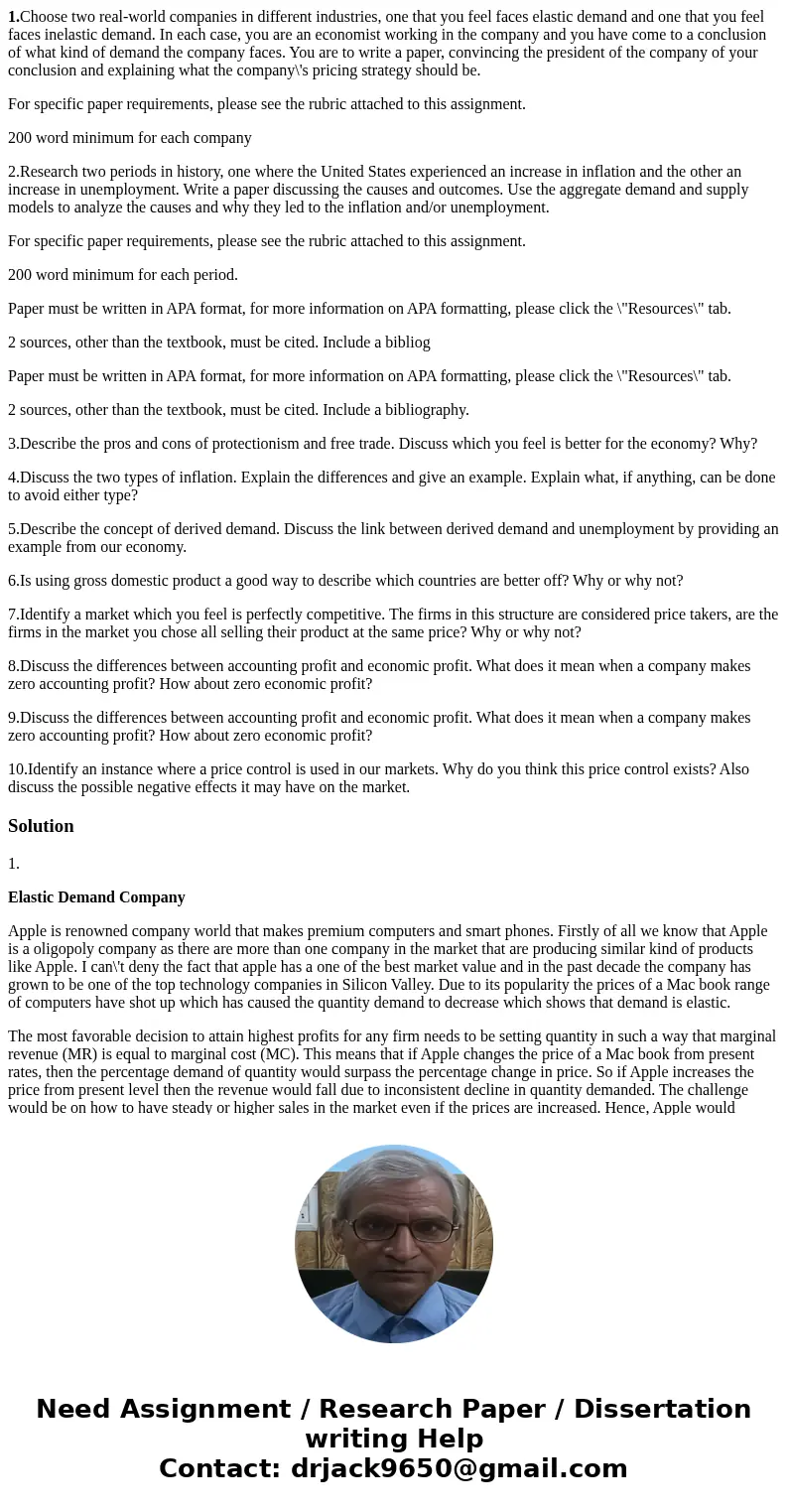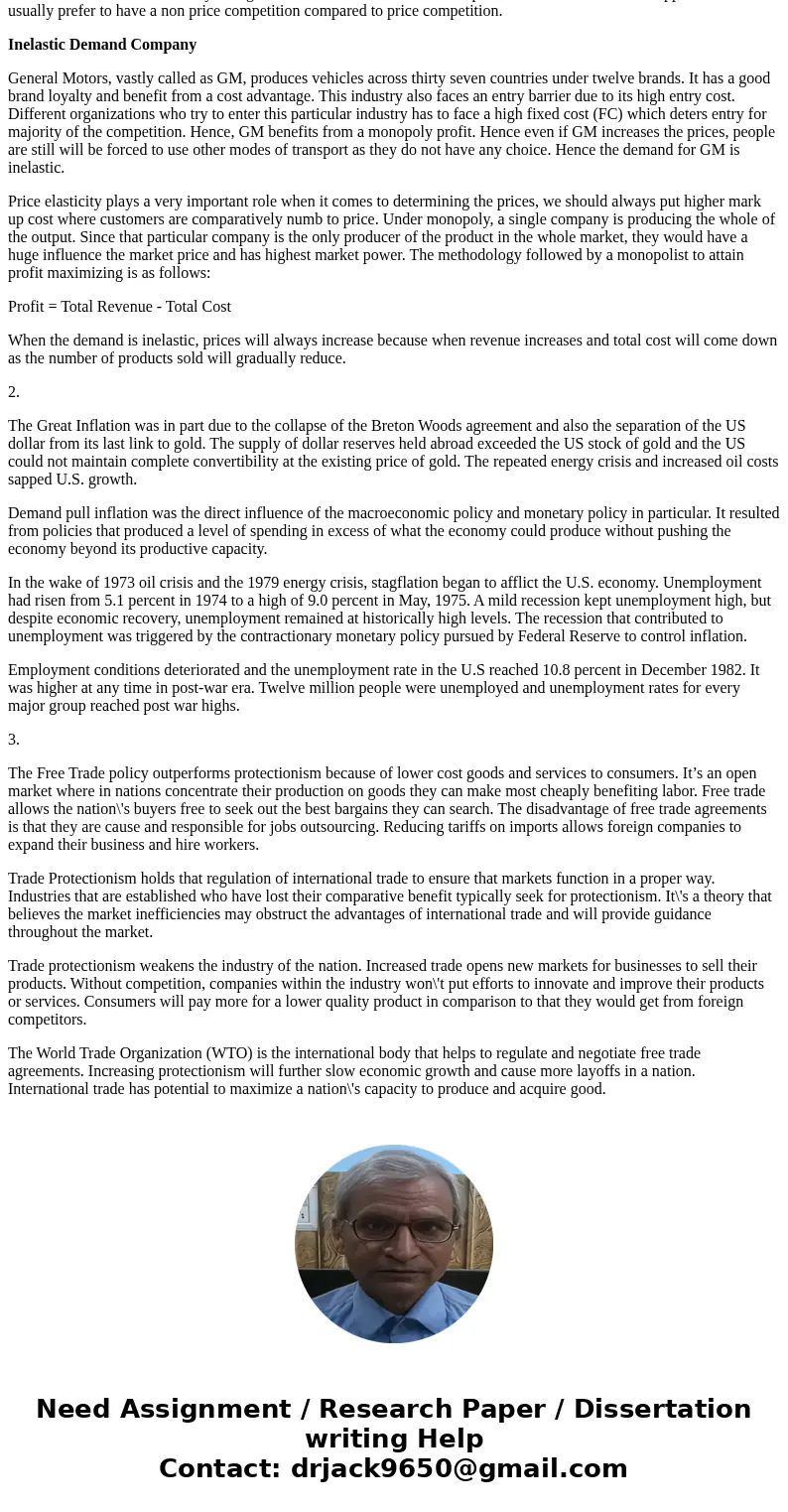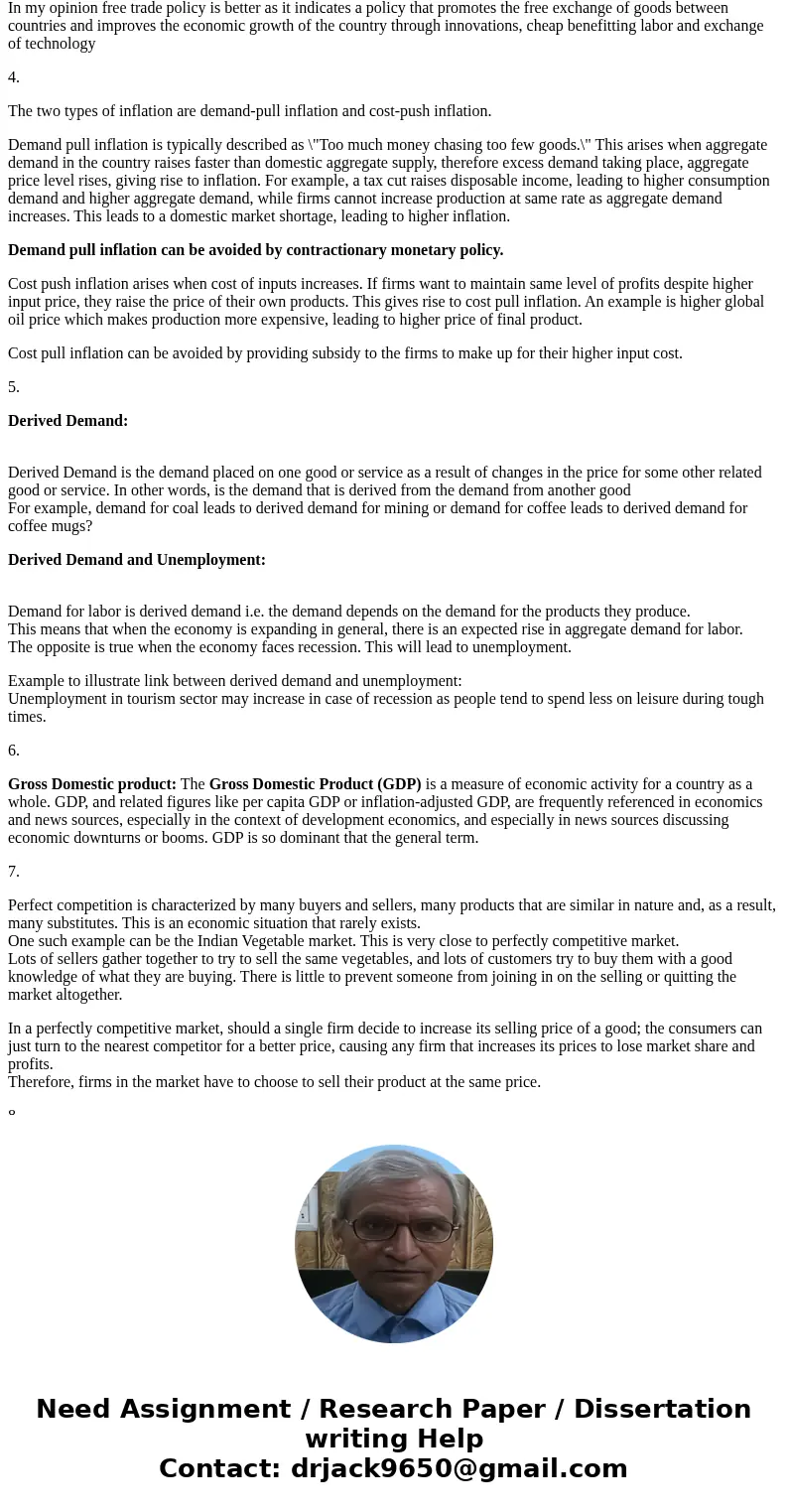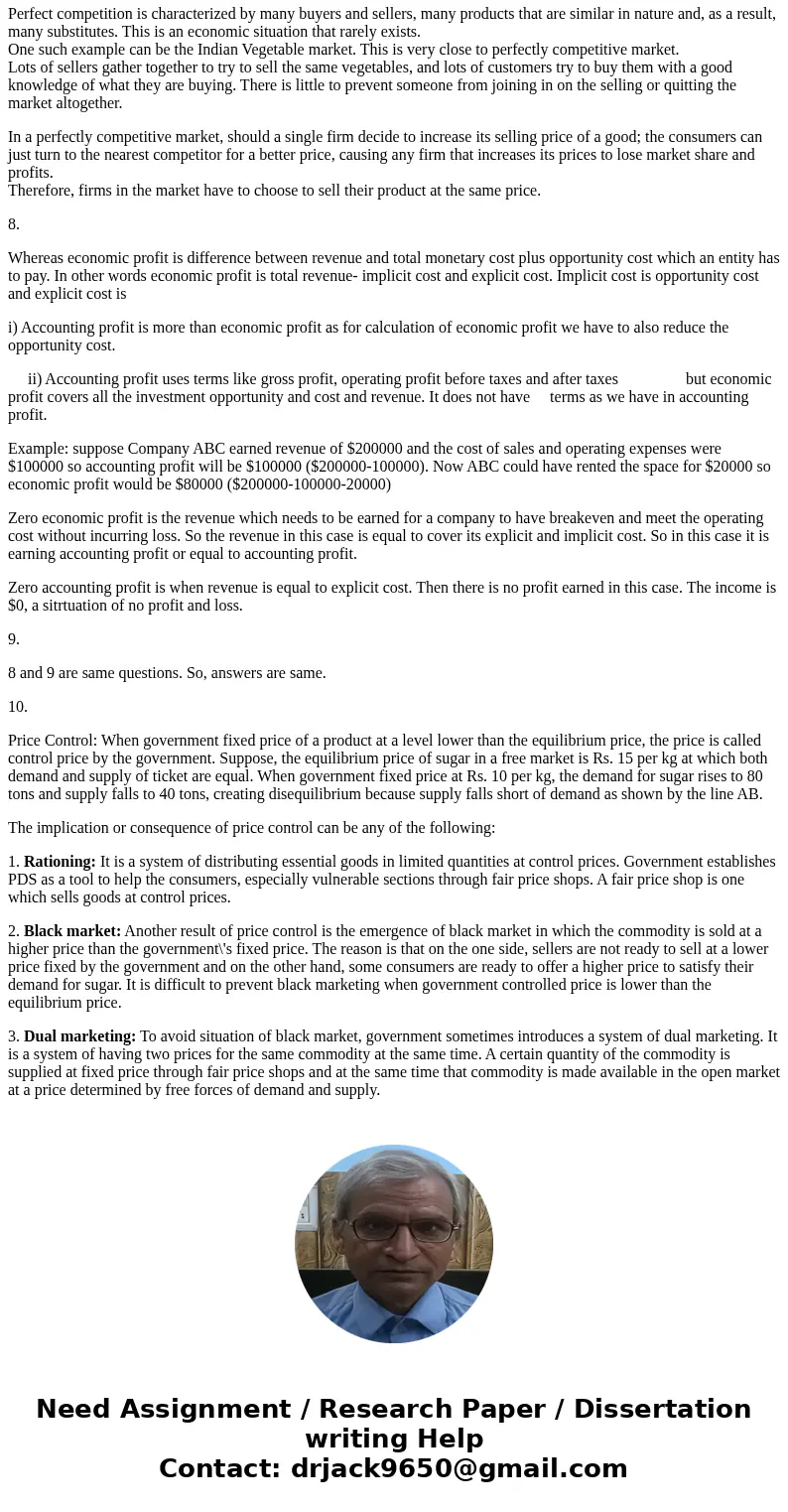1Choose two realworld companies in different industries one
1.Choose two real-world companies in different industries, one that you feel faces elastic demand and one that you feel faces inelastic demand. In each case, you are an economist working in the company and you have come to a conclusion of what kind of demand the company faces. You are to write a paper, convincing the president of the company of your conclusion and explaining what the company\'s pricing strategy should be.
For specific paper requirements, please see the rubric attached to this assignment.
200 word minimum for each company
2.Research two periods in history, one where the United States experienced an increase in inflation and the other an increase in unemployment. Write a paper discussing the causes and outcomes. Use the aggregate demand and supply models to analyze the causes and why they led to the inflation and/or unemployment.
For specific paper requirements, please see the rubric attached to this assignment.
200 word minimum for each period.
Paper must be written in APA format, for more information on APA formatting, please click the \"Resources\" tab.
2 sources, other than the textbook, must be cited. Include a bibliog
Paper must be written in APA format, for more information on APA formatting, please click the \"Resources\" tab.
2 sources, other than the textbook, must be cited. Include a bibliography.
3.Describe the pros and cons of protectionism and free trade. Discuss which you feel is better for the economy? Why?
4.Discuss the two types of inflation. Explain the differences and give an example. Explain what, if anything, can be done to avoid either type?
5.Describe the concept of derived demand. Discuss the link between derived demand and unemployment by providing an example from our economy.
6.Is using gross domestic product a good way to describe which countries are better off? Why or why not?
7.Identify a market which you feel is perfectly competitive. The firms in this structure are considered price takers, are the firms in the market you chose all selling their product at the same price? Why or why not?
8.Discuss the differences between accounting profit and economic profit. What does it mean when a company makes zero accounting profit? How about zero economic profit?
9.Discuss the differences between accounting profit and economic profit. What does it mean when a company makes zero accounting profit? How about zero economic profit?
10.Identify an instance where a price control is used in our markets. Why do you think this price control exists? Also discuss the possible negative effects it may have on the market.
Solution
1.
Elastic Demand Company
Apple is renowned company world that makes premium computers and smart phones. Firstly of all we know that Apple is a oligopoly company as there are more than one company in the market that are producing similar kind of products like Apple. I can\'t deny the fact that apple has a one of the best market value and in the past decade the company has grown to be one of the top technology companies in Silicon Valley. Due to its popularity the prices of a Mac book range of computers have shot up which has caused the quantity demand to decrease which shows that demand is elastic.
The most favorable decision to attain highest profits for any firm needs to be setting quantity in such a way that marginal revenue (MR) is equal to marginal cost (MC). This means that if Apple changes the price of a Mac book from present rates, then the percentage demand of quantity would surpass the percentage change in price. So if Apple increases the price from present level then the revenue would fall due to inconsistent decline in quantity demanded. The challenge would be on how to have steady or higher sales in the market even if the prices are increased. Hence, Apple would usually prefer to have a non price competition compared to price competition.
Inelastic Demand Company
General Motors, vastly called as GM, produces vehicles across thirty seven countries under twelve brands. It has a good brand loyalty and benefit from a cost advantage. This industry also faces an entry barrier due to its high entry cost. Different organizations who try to enter this particular industry has to face a high fixed cost (FC) which deters entry for majority of the competition. Hence, GM benefits from a monopoly profit. Hence even if GM increases the prices, people are still will be forced to use other modes of transport as they do not have any choice. Hence the demand for GM is inelastic.
Price elasticity plays a very important role when it comes to determining the prices, we should always put higher mark up cost where customers are comparatively numb to price. Under monopoly, a single company is producing the whole of the output. Since that particular company is the only producer of the product in the whole market, they would have a huge influence the market price and has highest market power. The methodology followed by a monopolist to attain profit maximizing is as follows:
Profit = Total Revenue - Total Cost
When the demand is inelastic, prices will always increase because when revenue increases and total cost will come down as the number of products sold will gradually reduce.
2.
The Great Inflation was in part due to the collapse of the Breton Woods agreement and also the separation of the US dollar from its last link to gold. The supply of dollar reserves held abroad exceeded the US stock of gold and the US could not maintain complete convertibility at the existing price of gold. The repeated energy crisis and increased oil costs sapped U.S. growth.
Demand pull inflation was the direct influence of the macroeconomic policy and monetary policy in particular. It resulted from policies that produced a level of spending in excess of what the economy could produce without pushing the economy beyond its productive capacity.
In the wake of 1973 oil crisis and the 1979 energy crisis, stagflation began to afflict the U.S. economy. Unemployment had risen from 5.1 percent in 1974 to a high of 9.0 percent in May, 1975. A mild recession kept unemployment high, but despite economic recovery, unemployment remained at historically high levels. The recession that contributed to unemployment was triggered by the contractionary monetary policy pursued by Federal Reserve to control inflation.
Employment conditions deteriorated and the unemployment rate in the U.S reached 10.8 percent in December 1982. It was higher at any time in post-war era. Twelve million people were unemployed and unemployment rates for every major group reached post war highs.
3.
The Free Trade policy outperforms protectionism because of lower cost goods and services to consumers. It’s an open market where in nations concentrate their production on goods they can make most cheaply benefiting labor. Free trade allows the nation\'s buyers free to seek out the best bargains they can search. The disadvantage of free trade agreements is that they are cause and responsible for jobs outsourcing. Reducing tariffs on imports allows foreign companies to expand their business and hire workers.
Trade Protectionism holds that regulation of international trade to ensure that markets function in a proper way. Industries that are established who have lost their comparative benefit typically seek for protectionism. It\'s a theory that believes the market inefficiencies may obstruct the advantages of international trade and will provide guidance throughout the market.
Trade protectionism weakens the industry of the nation. Increased trade opens new markets for businesses to sell their products. Without competition, companies within the industry won\'t put efforts to innovate and improve their products or services. Consumers will pay more for a lower quality product in comparison to that they would get from foreign competitors.
The World Trade Organization (WTO) is the international body that helps to regulate and negotiate free trade agreements. Increasing protectionism will further slow economic growth and cause more layoffs in a nation. International trade has potential to maximize a nation\'s capacity to produce and acquire good.
In my opinion free trade policy is better as it indicates a policy that promotes the free exchange of goods between countries and improves the economic growth of the country through innovations, cheap benefitting labor and exchange of technology
4.
The two types of inflation are demand-pull inflation and cost-push inflation.
Demand pull inflation is typically described as \"Too much money chasing too few goods.\" This arises when aggregate demand in the country raises faster than domestic aggregate supply, therefore excess demand taking place, aggregate price level rises, giving rise to inflation. For example, a tax cut raises disposable income, leading to higher consumption demand and higher aggregate demand, while firms cannot increase production at same rate as aggregate demand increases. This leads to a domestic market shortage, leading to higher inflation.
Demand pull inflation can be avoided by contractionary monetary policy.
Cost push inflation arises when cost of inputs increases. If firms want to maintain same level of profits despite higher input price, they raise the price of their own products. This gives rise to cost pull inflation. An example is higher global oil price which makes production more expensive, leading to higher price of final product.
Cost pull inflation can be avoided by providing subsidy to the firms to make up for their higher input cost.
5.
Derived Demand:
Derived Demand is the demand placed on one good or service as a result of changes in the price for some other related good or service. In other words, is the demand that is derived from the demand from another good
For example, demand for coal leads to derived demand for mining or demand for coffee leads to derived demand for coffee mugs?
Derived Demand and Unemployment:
Demand for labor is derived demand i.e. the demand depends on the demand for the products they produce.
This means that when the economy is expanding in general, there is an expected rise in aggregate demand for labor.
The opposite is true when the economy faces recession. This will lead to unemployment.
Example to illustrate link between derived demand and unemployment:
Unemployment in tourism sector may increase in case of recession as people tend to spend less on leisure during tough times.
6.
Gross Domestic product: The Gross Domestic Product (GDP) is a measure of economic activity for a country as a whole. GDP, and related figures like per capita GDP or inflation-adjusted GDP, are frequently referenced in economics and news sources, especially in the context of development economics, and especially in news sources discussing economic downturns or booms. GDP is so dominant that the general term.
7.
Perfect competition is characterized by many buyers and sellers, many products that are similar in nature and, as a result, many substitutes. This is an economic situation that rarely exists.
One such example can be the Indian Vegetable market. This is very close to perfectly competitive market.
Lots of sellers gather together to try to sell the same vegetables, and lots of customers try to buy them with a good knowledge of what they are buying. There is little to prevent someone from joining in on the selling or quitting the market altogether.
In a perfectly competitive market, should a single firm decide to increase its selling price of a good; the consumers can just turn to the nearest competitor for a better price, causing any firm that increases its prices to lose market share and profits.
Therefore, firms in the market have to choose to sell their product at the same price.
8.
Whereas economic profit is difference between revenue and total monetary cost plus opportunity cost which an entity has to pay. In other words economic profit is total revenue- implicit cost and explicit cost. Implicit cost is opportunity cost and explicit cost is
i) Accounting profit is more than economic profit as for calculation of economic profit we have to also reduce the opportunity cost.
ii) Accounting profit uses terms like gross profit, operating profit before taxes and after taxes but economic profit covers all the investment opportunity and cost and revenue. It does not have terms as we have in accounting profit.
Example: suppose Company ABC earned revenue of $200000 and the cost of sales and operating expenses were $100000 so accounting profit will be $100000 ($200000-100000). Now ABC could have rented the space for $20000 so economic profit would be $80000 ($200000-100000-20000)
Zero economic profit is the revenue which needs to be earned for a company to have breakeven and meet the operating cost without incurring loss. So the revenue in this case is equal to cover its explicit and implicit cost. So in this case it is earning accounting profit or equal to accounting profit.
Zero accounting profit is when revenue is equal to explicit cost. Then there is no profit earned in this case. The income is $0, a sitrtuation of no profit and loss.
9.
8 and 9 are same questions. So, answers are same.
10.
Price Control: When government fixed price of a product at a level lower than the equilibrium price, the price is called control price by the government. Suppose, the equilibrium price of sugar in a free market is Rs. 15 per kg at which both demand and supply of ticket are equal. When government fixed price at Rs. 10 per kg, the demand for sugar rises to 80 tons and supply falls to 40 tons, creating disequilibrium because supply falls short of demand as shown by the line AB.
The implication or consequence of price control can be any of the following:
1. Rationing: It is a system of distributing essential goods in limited quantities at control prices. Government establishes PDS as a tool to help the consumers, especially vulnerable sections through fair price shops. A fair price shop is one which sells goods at control prices.
2. Black market: Another result of price control is the emergence of black market in which the commodity is sold at a higher price than the government\'s fixed price. The reason is that on the one side, sellers are not ready to sell at a lower price fixed by the government and on the other hand, some consumers are ready to offer a higher price to satisfy their demand for sugar. It is difficult to prevent black marketing when government controlled price is lower than the equilibrium price.
3. Dual marketing: To avoid situation of black market, government sometimes introduces a system of dual marketing. It is a system of having two prices for the same commodity at the same time. A certain quantity of the commodity is supplied at fixed price through fair price shops and at the same time that commodity is made available in the open market at a price determined by free forces of demand and supply.




 Homework Sourse
Homework Sourse